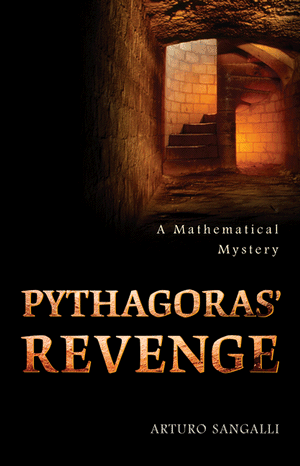
Pythagoras’ Revenge: A Mathematical Mystery
by Arturo Sangalli
-Reviewed by Jodie Liu
The Pythagorean Theorem may be the unquestionable basis for triangular geometry, but its origins are much less certain. Pythagoras himself firmly believed against documenting his reasoning methods and thus left behind no written work – or so it is believed.
More than two millennia after Pythagoras’ death, Arturo Sangalli constructs the “what if?” narrative surrounding the hypothetical contents of a long-lost scroll by the mathematician, with the intent of both corroborating and challenging “the triumph and tyranny of numbers” in modern societies. Like Dan Brown’s Da Vinci Code, Sangalli’s Pythagoras’ Revenge takes advantage of history’s incomplete documentation by filling in the spaces with a plausible, but fictional, conspiracy mystery.
In Sangalli’s tale, two scholars develop reason to believe that the mysterious Greek mathematician left behind a single scroll and took extraordinary precautions to ensure its preservation. Jule Davidson is an American mathematician who is recruited for his mathematical reasoning ability by the Beacon, a pseudo-religious cult Across the Atlantic Ocean from Davidson and the Beacon, Elmer Galway, an Oxford historian, is roped into the “shroud of mystery” that surrounds Pythagoras when he comes into possession of a centuries-old Greek text hinting at the existence of an original Pythagorean scroll that “must be protected at all costs.” Upon observing that the centuries-old Greek text may merely be the first half of a complete text, Elmer attempts to acquire the second half of the document, which Davidson has.
Sangalli jokes that, for once, the whole is not greater than the sum of its parts: in the case of Galway and Davidson’s texts, two halves are worth more than one whole item in an auction. The same cannot be said, however, of Galway and Davidson themselves, for their characters matter less as individuals and more for the contrast they create. Davidson’s focus on mathematical contribution opposes Galway’s emphasis on historical significance, and Galway’s skepticism resists Davidson’s willingness to accept the supernatural. But Sangalli actually sets out to bridge these divides and others – antiquity and modernity, the scientific and the supernatural, order and chaos – by suggesting that diametric opposites can coexist harmoniously.
But for all of his ambitious designs, Sangalli acknowledges that such weighty debate cannot be easily resolved. It sometimes seems as though Sangalli resolves elements of the mystery too swiftly, making his great philosophical inquiries feel too neat. Yet, Sangalli’s story also shows that the real mystery rests in perpetually elusive questions of mathematical existence – both math’s existence as a number and order-based science and its philosophical existence as seen through the lens of mathematical theories – that perhaps should never be answered at all.
Excerpt: “‘Our old friend Pythagoras thought he had discovered the key to the mysteries of the universe: the world was ruled by numbers in an orderly and immutable way. ‘All is number,’ he taught, and so by unlocking the secrets of numbers one could understand anything. He may turn in his grave is he learned that the secrets of numbers are for the most part impenetrable and the fabric of reality is made up of chaos and unpredictability.’”
Further Reading: The Pythagorean Sourcebook and Library: An Anthology of Ancient Writings Which Relate to Pythagoras and Pythagorean Philosophy and Mathematical Mysteries: The Beauty and Magic of Numbers




Send A Letter To the Editors